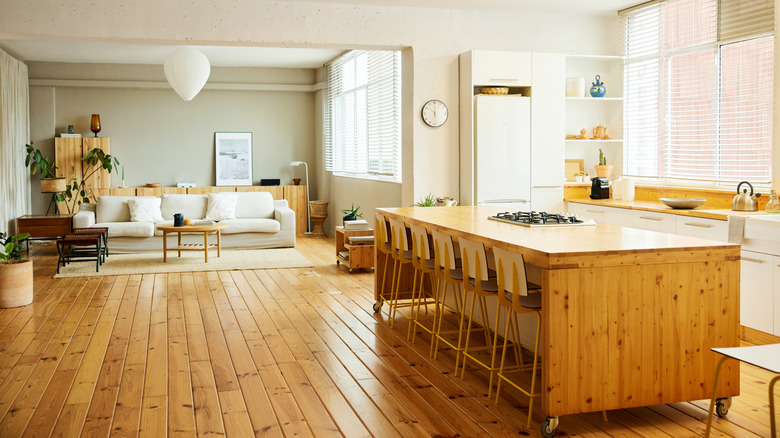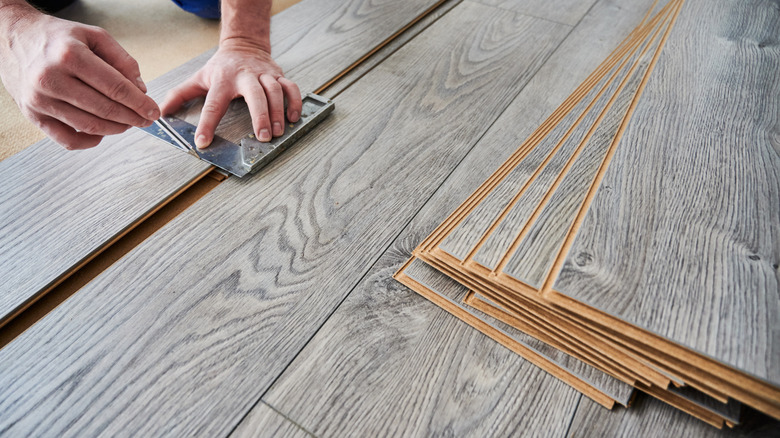How To Identify What Type Of Wood Your Flooring Is Made Of
There are many different types of wood that your floors can be made of. Some hardwood floors are costly and give a home a rustic look, while affordable types of hardwood floors can look more expensive than they really are. If you didn't install the floors yourself, though, how can you tell what type of wood your flooring is? House Digest spoke exclusively with Bob Beacham, House Digest's expert carpenter and remodeler, to learn how to identify your hardwood floor's wood type and why this is important in the first place.
Beacham shared that knowing the type of wood flooring in your home is imperative to the day-to-day maintenance of your floors. "Knowing whether it's hardwood, engineered, or laminate will be important for the choice of cleaning products and method," Beacham said. However, it's also good to know if you ever need to replace a board or refinish the surface. "If you need to replace part of a solid wood floor, it will be important because the wrong grain will stand out dramatically even if you use an all-over stain," Beacham explained.
According to Beacham, there are two key characteristics that can help you identify the type of wood: the grain and the color. However, if your flooring has been treated or stained, looking at the color may not be the best option. Beacham suggests looking for a spot that isn't treated, such as near a wall, or if worst comes to worst, sand a small portion of the flooring where no one will see it to get a good look.
How to identify the type of flooring in your home
Hardwood is one of the flooring options that can help increase your home's resale value, so it's understandable that you want to identify what type you have installed in your property. As Bob Beacham said in his exclusive interview with House Digest, knowing the age of your flooring can be important. Beacham shared that the wood types you are most likely to find are maple, white oak, red oak, cherry, hickory, and sometimes walnut. However, if your flooring is older, you may also see softwood floors, which can include pine, fir, cedar, and spruce. To help determine which wood you have, Beacham suggests you start with an online search. "You'll get a selection of images," he explained. "They may be similar to your floor, they may be radically different. Images from flooring companies will usually narrow it down to a half dozen or so types. If you think you've found your wood type, check it against two or three sources to confirm." However, Beacham recommends that you avoid wood databases, which can provide too many results and lead to more confusion than answers.
Of course, there are some instances where deciding what type of flooring you have may be too difficult for the average homeowner. "The challenge comes if you have some kind of exotic hardwood floor," Beacham said. "They can be hard to pin down, and you might need to call in a carpenter or flooring pro. Before you do that, check whether it's actually hardwood, softwood, or maybe engineered, or laminate."
Engineered wood, hardwood, or laminate
While knowing the type of wood flooring you have is important, it is equally important to know if your flooring is laminate, solid wood, or engineered wood. During House Digest's exclusive interview with Bob Beacham, he explained how to identify the differences in these types of wood. "Engineered wood is technically a laminate because it's multiple layers, but it's still a real wood slice on top of a chipboard, plywood, or fiberboard core," Beacham said. "There is no wood in laminates. It's a photo of wood on top of some kind of composite board, with a clear protective wear layer over the top." To identify what type of floor you have, Beacham suggests looking at the edge or end of one of the boards, and it will be fairly obvious. You can also look at the grain of your board. If you see varied patterns across each board and feel texture, then it's likely you have solid wood. If each board looks identical, it's probably laminate.
For the difference between solid wood vs. engineered wood, knocking on the floor can also give you a hint. If the wood sounds hollow, it's probably engineered, whereas solid wood would sound solid. "There aren't any perfect ways to identify, but adding them all together should give you a pretty good idea," Beacham explained. "If you're not sure, and you really need to know, call a pro."


